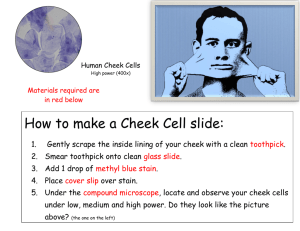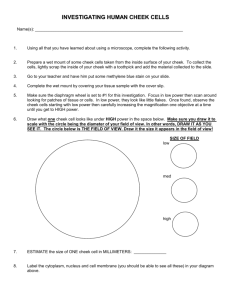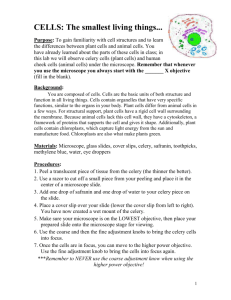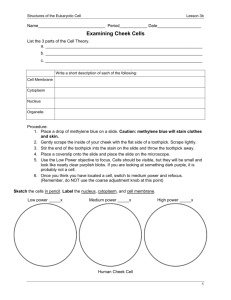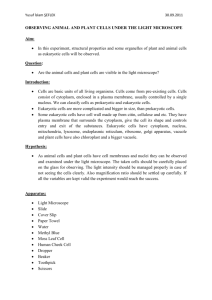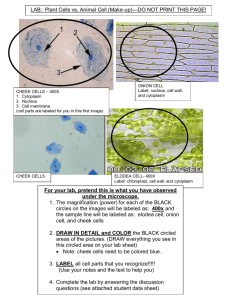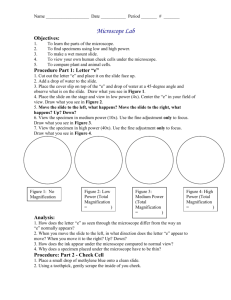IDF Bilkent Erzurum Laboratory High School
advertisement
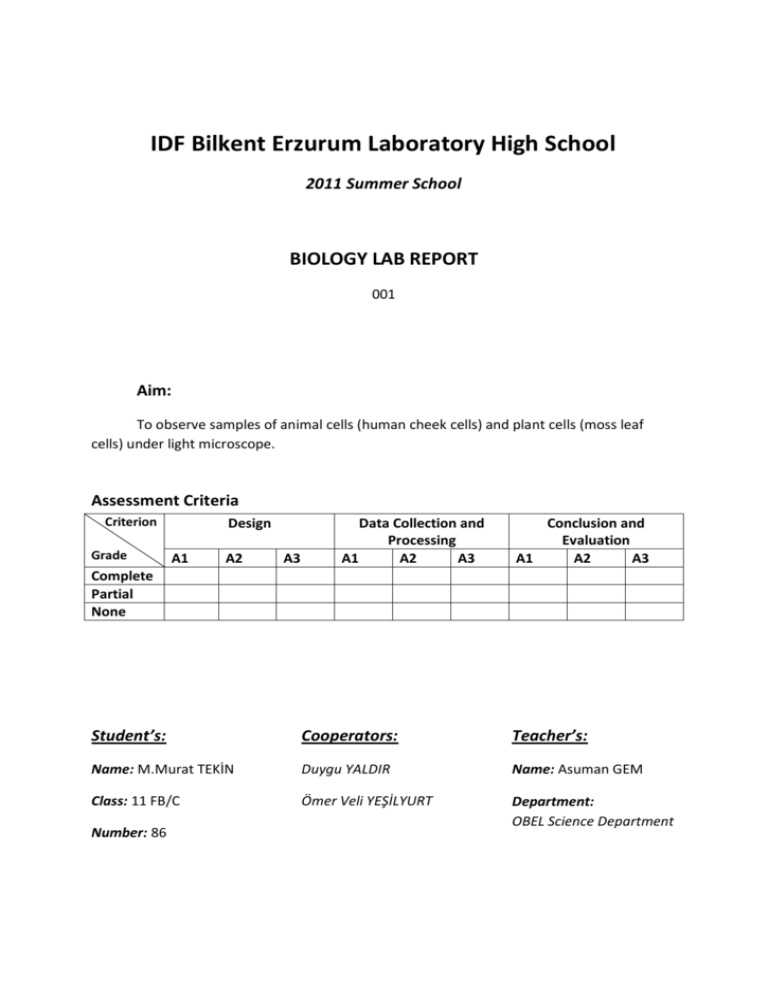
IDF Bilkent Erzurum Laboratory High School 2011 Summer School BIOLOGY LAB REPORT 001 Aim: To observe samples of animal cells (human cheek cells) and plant cells (moss leaf cells) under light microscope. Assessment Criteria Criterion Grade Design A1 A2 A3 Data Collection and Processing A1 A2 A3 Conclusion and Evaluation A1 A2 A3 Complete Partial None Student’s: Cooperators: Teacher’s: Name: M.Murat TEKİN Duygu YALDIR Name: Asuman GEM Class: 11 FB/C Ömer Veli YEŞİLYURT Department: OBEL Science Department Number: 86 M. Murat TEKİN 11 FB-C 12.08.2011 Biology Lab Report 001 Aim To observe samples of animal cells (human cheek cells) and plant cells (moss leaf cells) under light microscope. Procedure: Apparatus o Light Microscope o Beaker (100 ml) o Dropper o 2 cover slips o 2 slides o Toothpicks o Scissors o Paper Towel Chemicals o Methyl blue o Water Observed Samples o Human cheek cells o Moss leaf cells In the beginning the apparatus for the experiment were prepared and checked for usability. Then the human cheek cell samples were to be prepared. To prepare the human cheek cell sample, one drop of water was taken from the readily filled 100ml beaker. Then the drop of water was placed on the slide. After that with one end of a toothpick, the inner part of the cheek was rubbed several times to get some cheek cells. Then that end of the toothpick was placed on the drop of water on the slide. It was moved through the water drop to detach the cheek cells from it, into the water drop. After that the sample was colored with a drop of methyl blue, so that the nucleus of the cells could be seen under light microscope. Then the cover slip was carefully placed on the sample not to leave air bubbles inside it. Excess water was wiped with the paper towel. The microscope was plugged in. Then its magnifying lenses were set to 4X and the sample was placed on the stage of the microscope. The ocular lenses had a magnification of 5X. So the magnification of the observed sample was 20X. To get a clear sight, the sample’s position was adjusted by using coarse and fine adjustment knobs. The sample was observed. The cells were not seen at that magnification, but cell groups were seen like blue spots. By sliding the sample, one of the cell groups was brought into the middle point of the viewed part. Then the magnifying lenses were set to 10X, which created a resultant magnification of 50X. The adjustment knobs were used to get a clear view of the sample. This time the cells could be seen as little spots on the slide. Their round shape was also recognized. One of the cells in the cell group was brought to the midpoint of the viewed part. 1 M. Murat TEKİN 11 FB-C 12.08.2011 When the magnifying lenses were set to 40X, the resultant magnification was 200X. The adjustment knobs were used several times to get a clear view of the sample. Also the light intensity was lowered to increase the details of the view. The cell’s shape, nucleus and cytoplasm were in the view. The whole procedure was repeated using another sample from another person’s cheek. The cells observed were pretty similar to the ones observed in first sample. A scientific drawing of the view was made and handed out to the invigilating teacher. To prepare the moss leaf cell sample, a drop of water was placed on another slide by using a dropper. A thin slide of moss leaf was cut using the scissors. It was placed on the slide and without coloring; the cover slip was placed on the sample. The sample was placed on the diaphragm of the microscope. The observing procedure was repeated the same way as it was for the human cheek cells. At 20X magnification the cells were seen in aligned on lines. At 50X magnification, individual cells could be seen and their rectangular shapes were observed. Also the green chloroplasts could be recognized in groups. At 200X magnification, the cell nucleuses were seen as dark points at the sides of the plant cells. The central vacuoles were recognized as smooth white spaces inside the cells. The chloroplasts were seen as separate green points. The cell walls were seen as relatively dark lines between the cells. The stomata and guard cells were distinguished. Also a transport structure was observed as a long, stripped line between some cells. The procedure was repeated using another sample. There was not a great difference between the views. A scientific drawing of the last observed view was drawn and it was handed out to the invigilating teacher. Conclusion The experiment can be considered to be a successful one, because many organelles inside the plant and animal cells were observed. The chloroplasts and nucleus were the organelles easily viewed. Also the structural differences between two different cell types were clearly seen. The cell walls of plant cells, the chloroplasts inside them and their large vacuoles were the most distinguishable properties of plant cells that were not observed in animal cells. Also the plant cells were seen rectangular whereas the animal cells were round shaped. In addition to these, the main characteristics of eukaryotic cells were recognized in both cells. They both had a spherical nucleus separate from the cytoplasm. The plant cells had chloroplasts which couldn’t be found in a prokaryotic cell. The main source of error in the experiment was the wrong use of microscopes. During the experiment, the 40X magnifying lens touched the sample and it wasn’t cleaned well. Another important source of error was the water used. Tap water was dropped on the samples instead of diluted water. As the tap water may contain undesired particles inside it, it wouldn’t be safe to use for a microscopic observation. 2 M. Murat TEKİN 11 FB-C 12.08.2011 Evaluation Firstly, the slides used should have been cleaned carefully before the experiment so that nothing remained on them. This would be an important improvement for the experiment because during observation dust particles on the slide could cause blurry vision, which is not wanted for the health of the experiment. Also the 40X magnifying lens should have been replaced by another one after it touched the sample. Even though it was cleaned, there still remained some tiny spots on it, which spoiled the view of the observed cells. The scientific drawings made could be considered as a source of error in recording the views. Taking a photograph of the views would be far better than drawing the view on a paper. A strong point about the experiment was the repetition with different samples. For both cell types, two different samples were observed, to avoid any errors caused by different, special characteristics of the samples. 3
